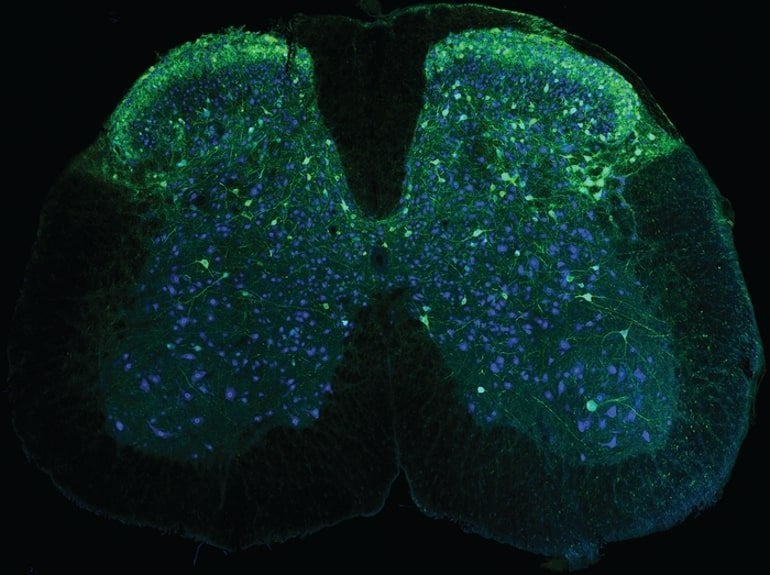Summary: A newly invented wearable microscope produces high-definition and real-time images of neurons and activity in the mouse spinal cord in previously inaccessible regions.
Source: Salk Institute
The spinal cord acts as a messenger, carrying signals between the brain and body to regulate everything from breathing to movement. While the spinal cord is known to play an essential role in relaying pain signals, technology has limited scientists’ understanding of how this process occurs on a cellular level.
Now, Salk scientists have created wearable microscopes to enable unprecedented insight into the signaling patterns that occur within the spinal cords of mice.
This technological advancement, detailed in two papers published in Nature Communications on March 21, 2023, and Nature Biotechnology on March 6, 2023, will help researchers better understand the neural basis of sensations and movement in healthy and disease contexts, such as chronic pain, itch, amyotrophic lateral sclerosis (ALS), or multiple sclerosis (MS).
“These new wearable microscopes allow us to see nerve activity related to sensations and movement in regions and at speeds inaccessible by other high-resolution technology,” says senior author Axel Nimmerjahn, associate professor and director of the Waitt Advanced Biophotonics Center. “Our wearable microscopes fundamentally change what is possible when studying the central nervous system.”
The wearable microscopes are approximately seven- and fourteen- millimeters wide (about the width of a little finger or the human spinal cord) and offer high-resolution, high-contrast, and multicolor imaging in real-time across previously inaccessible regions of the spinal cord. The new technology can be combined with a microprism implant, which is a small reflective glass element placed near the tissue regions of interest.
“The microprism increases the depth of imaging, so previously unreachable cells can be viewed for the first time. It also allows cells at various depths to be imaged simultaneously and with minimal tissue disturbance,” says Erin Carey, co-first author of one of the studies and researcher in Nimmerjahn’s lab.

Pavel Shekhtmeyster, a former postdoctoral fellow in Nimmerjahn’s lab and co-first author on both studies, agrees, “We’ve overcome field-of-view and depth barriers in the context of spinal cord research. Our wearable microscopes are light enough to be carried by mice and allow measurements previously thought impossible.”
With the novel microscopes, Nimmerjahn’s team began applying the technology to gather new information about the central nervous system. In particular, they wanted to image astrocytes, star-shaped non-neuronal glial cells, in the spinal cord because the team’s earlier work suggested the cells’ unexpected involvement in pain processing.
The team found that squeezing the tails of mice activated the astrocytes, sending coordinated signals across spinal cord segments. Prior to the invention of the new microscopes, it was impossible to know what astrocyte activity looked like—or what any cellular activity looked like across those spinal cord regions of moving animals.
“Being able to visualize when and where pain signals occur and what cells participate in this process allows us to test and design therapeutic interventions,” says Daniela Duarte, co-first author of one of the studies and researcher in Nimmerjahn’s lab. “These new microscopes could revolutionize the study of pain.”
Nimmerjahn’s team has already begun investigating how neuronal and non-neuronal activity in the spinal cord is altered in different pain conditions and how various treatments control abnormal cell activity.
Other authors include Alexander Ngo, Grace Gao, Nicholas A. Nelson, Jack A. Olmstead, and Charles L. Clark of Salk.
Funding: The work was supported by the National Institutes of Health (R01NS108034, U19NS112959, U19NS123719, U01NS103522, and F31NS120619), a National Institutes of Health Training Grant (T32/CMG), the Sol Goldman Charitable Trust, C. and L. Greenfield, a Rose Hills Foundation Graduate Fellowship, a Burt and Ethel Aginsky Research Scholar Award, a Kavli-Helinski Endowment Graduate Fellowship, and a Salk Innovation Grant.
About this neurotech research news
Author: Press Office
Source: Salk Institute
Contact: Press Office – Salk Institute
Image: The image is credited to Salk Institute
Original Research: Open access.
“Multiplex translaminar imaging in the spinal cord of behaving mice” by Axel Nimmerjahn et al. Nature Communications
Open access.
“Trans-segmental imaging in the spinal cord of behaving mice” by Axel Nimmerjahn et al. Nature Biotechnology
Abstract
Multiplex translaminar imaging in the spinal cord of behaving mice
While the spinal cord is known to play critical roles in sensorimotor processing, including pain-related signaling, corresponding activity patterns in genetically defined cell types across spinal laminae have remained challenging to investigate. Calcium imaging has enabled cellular activity measurements in behaving rodents but is currently limited to superficial regions.
Here, using chronically implanted microprisms, we imaged sensory and motor-evoked activity in regions and at speeds inaccessible by other high-resolution imaging techniques. To enable translaminar imaging in freely behaving animals through implanted microprisms, we additionally developed wearable microscopes with custom-compound microlenses.
This system addresses multiple challenges of previous wearable microscopes, including their limited working distance, resolution, contrast, and achromatic range. Using this system, we show that dorsal horn astrocytes in behaving mice show sensorimotor program-dependent and lamina-specific calcium excitation.
Additionally, we show that tachykinin precursor 1 (Tac1)-expressing neurons exhibit translaminar activity to acute mechanical pain but not locomotion.
Abstract
Trans-segmental imaging in the spinal cord of behaving mice
Spinal cord circuits play crucial roles in transmitting pain, but the underlying activity patterns within and across spinal segments in behaving mice have remained elusive.
We developed a wearable widefield macroscope with a 7.9-mm2 field of view, ~3- to 4-μm lateral resolution, 2.7-mm working distance and <10-g overall weight and show that highly localized painful mechanical stimuli evoke widespread, coordinated astrocyte excitation across multiple spinal segments.






